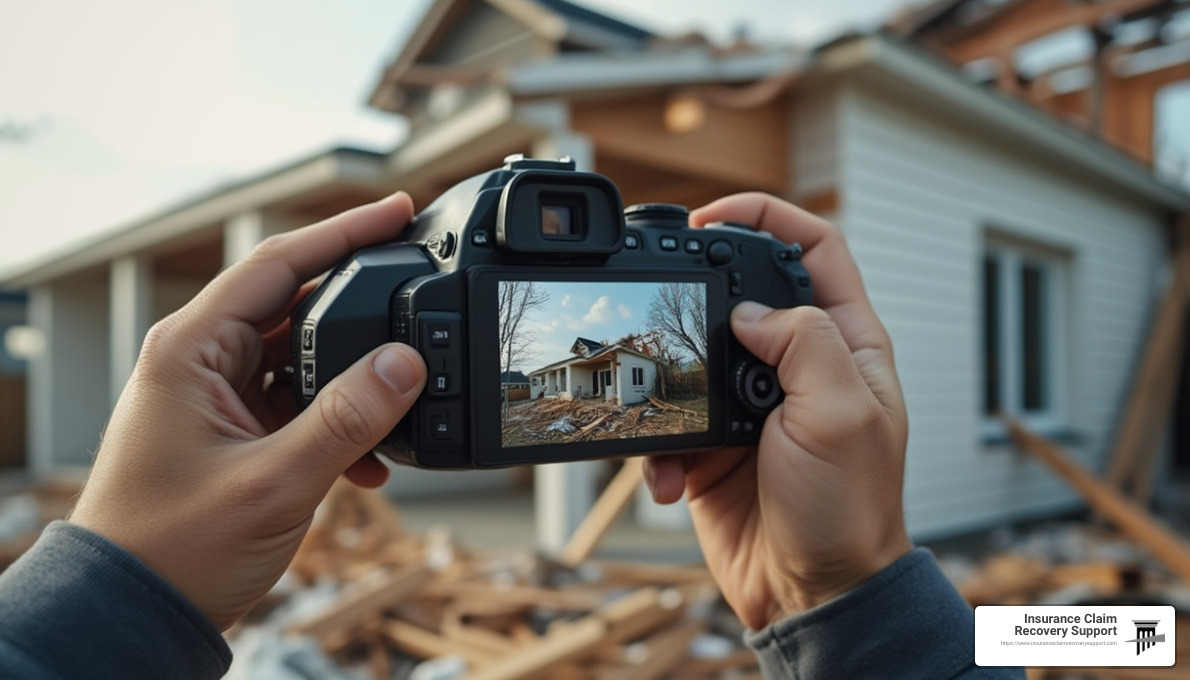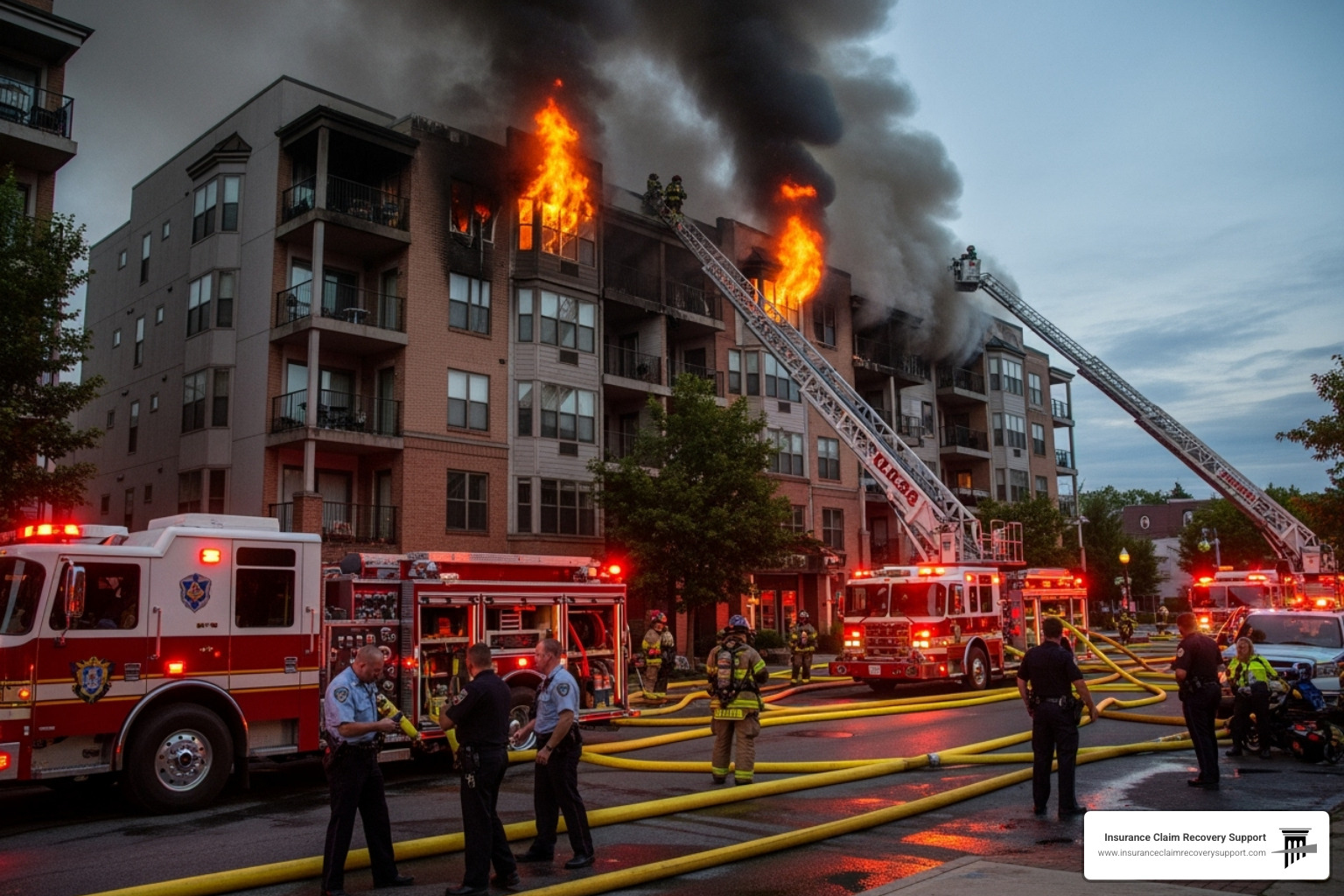Large loss claim documentation lists are crucial for anyone dealing with severe property damage. Whether from hurricanes, fires, or floods, these lists ensure that insurance claims are processed smoothly and efficiently. Here’s what you need:
- Immediate Photographic Evidence: Take photos and videos of all damages immediately.
- Detailed Damage Inventory: Create an itemized list of damaged property, including descriptions and estimated values.
- Professional Assessments: Secure reports from contractors or experts to validate damage costs.
- Financial Documentation: Gather receipts, purchase orders, and financial records to substantiate claims.
Navigating the stressful aftermath of a disaster is daunting, especially when substantial insurance claims are on the line. Property owners, especially in multifamily and commercial sectors, often encounter complex challenges in ensuring their claims are accurately assessed and promptly processed. As these pivotal decisions impact ongoing business operations, knowing what documentation to gather can be the difference between a quick recovery and prolonged financial strain.
I’m Scott Friedson. With years of experience overseeing large loss claims, I’ve helped countless policyholders maximize their insurance settlements by using comprehensive large loss claim documentation lists. My expertise ensures that you receive the fair compensation necessary to rebuild and move forward.

Easy large loss claim documentation lists glossary:
– commercial large loss claim
– large loss claims
– what is a large loss claim
Understanding Large Loss Claims
When disaster strikes, the aftermath can be overwhelming, especially if you’re dealing with a large loss claim. These claims involve significant property damage and can have a profound impact on your business operations and revenue. Understanding what constitutes a large loss claim and its common causes is crucial for navigating the claims process effectively.
Definition
A large loss claim isn’t just about the dollar amount of the damage. While it typically involves damages exceeding $200,000, it’s also about the extent of the impact on business operations. Even a small business can face a large loss if the damage halts operations and cuts off revenue.
Common Causes
Large loss claims often stem from severe and unexpected events. Here are some of the most common causes:
- Natural Disasters: Hurricanes, tornadoes, floods, and earthquakes can cause widespread and devastating damage.
- Fires: A fire can quickly cause extensive harm to both structure and contents.
- Hailstorms: While sometimes overlooked, hail can cause significant damage to roofs and windows.
- Freezing Conditions: Burst pipes and water damage from freezing can lead to costly repairs.
Impact on Business
The impact of a large loss claim goes beyond the immediate physical damage. Here are some ways it can affect your business:
- Operational Disruption: Damage can halt production, delay services, and lead to temporary closures, affecting your bottom line.
- Financial Strain: Repair costs can be overwhelming, especially if insurance claims are underpaid or delayed.
- Emotional Toll: Navigating the claims process can be stressful and time-consuming, adding to the emotional burden of recovering from a disaster.
Understanding these elements is the first step in managing a large loss claim effectively. With the right documentation and support, you can steer this challenging process and secure the compensation you need to rebuild.
Essential Documentation for Large Loss Claims
When you’re dealing with a large loss claim, having the right documentation is key. This isn’t just about keeping track of damage—it’s about making sure you get the compensation you deserve. Here’s what you need to know about the essential documents required.
Proof of Loss
The Proof of Loss form is a critical document in the claims process. It’s your formal statement to the insurance company detailing the extent and value of the loss. This form must be filled out accurately and submitted within the timeline specified by your policy. Missing this deadline can lead to delays or denials.
Make sure your proof of loss includes:
- Detailed Descriptions: Clearly describe the damage and its impact.
- Estimated Costs: Provide an accurate estimate of repair or replacement costs.
- Supporting Evidence: Attach photos, videos, receipts, and other documentation to substantiate your claim.
Itemized Lists
An itemized list is a breakdown of all damaged or lost items. This list helps establish the value of your claim and ensures nothing is overlooked. Here’s how to create an effective itemized list:
- Categorize Items: Group items into categories like furniture, electronics, or inventory.
- Include Details: For each item, include descriptions, purchase dates, and values.
- Use Pre-Loss Inventories: If you have pre-loss inventory lists, use them to verify and support your claims.
Creating a thorough itemized list not only helps in calculating your loss but also strengthens your position during negotiations with the insurance company.
Supporting Documentation
Supporting documentation is what backs up your claims and adds credibility to your proof of loss. Here are some key types of supporting documents:
- Receipts and Invoices: These provide proof of purchase and help establish the value of lost items.
- Appraisals: For high-value items like art or jewelry, professional appraisals are essential.
- Maintenance Records: These can demonstrate the pre-loss condition of your property and counter claims of negligence.
The more comprehensive your documentation, the stronger your claim. Insurance companies scrutinize large loss claims closely, so having robust documentation is crucial.
By gathering and organizing these documents, you position yourself for a smoother claims process and increase your chances of receiving fair compensation. Next, we’ll explore how public adjusters can assist in navigating large loss claims.
Large Loss Claim Documentation Lists
When disaster strikes and you’re faced with a large loss claim, having the right documentation can make all the difference. Let’s break down the essentials: photos and videos, receipts, and appraisals.
Photos and Videos
Visual evidence is your best friend in a large loss claim. Photos and videos capture the immediate aftermath and the extent of the damage. Here’s how to make the most of them:
- Take Extensive Shots: Capture wide shots of entire rooms and close-ups of specific damages. Different angles provide a full perspective of the loss.
- Document Everything: Don’t just focus on the obvious damage. Include hidden damages that might not be immediately apparent.
- Time-Stamp Your Evidence: Ensure your photos and videos are time-stamped to confirm when the documentation took place.
These visuals serve as irrefutable evidence and can be pivotal in substantiating your claim.
Receipts
Receipts are crucial for proving the value of lost or damaged items. Here’s how to use them effectively:
- Gather All Relevant Receipts: Collect receipts for all items included in your claim. This includes personal property, equipment, and any recent repairs or upgrades.
- Organize by Category: Sort receipts into categories like electronics, furniture, or structural repairs. This organization helps in quickly verifying claims.
- Include Purchase Details: Make sure each receipt includes the purchase date and price.
Receipts not only establish ownership but also help determine the replacement value of lost items.
Appraisals
For high-value items, appraisals are indispensable. They provide an expert valuation that can support your claim:
- Get Professional Appraisals: For items like jewelry, art, or antiques, a professional appraisal can accurately determine their worth.
- Update Regularly: Keep appraisals up-to-date to reflect current market values.
- Include in Your Documentation: Attach appraisals to your proof of loss to substantiate your claim further.
Appraisals can be particularly useful in negotiations, as they provide a third-party valuation that can counter low offers from the insurance company.
By carefully gathering and organizing these documents, you lay a strong foundation for your large loss claim. This documentation not only supports your proof of loss but also positions you for successful negotiations. Next, we’ll discuss how public adjusters can play a vital role in navigating large loss claims.
The Role of Public Adjusters in Large Loss Claims
When you’re dealing with a large loss claim, the process can be overwhelming. This is where public adjusters come into play. These professionals act as your personal advocates, helping you steer the complex world of insurance claims.
What Do Public Adjusters Do?
Public adjusters are licensed professionals who specialize in managing and negotiating insurance claims on behalf of policyholders. Unlike the adjusters sent by your insurance company, public adjusters work for you. Their primary goal is to ensure you receive the maximum settlement possible.
Here’s what public adjusters do:
- Evaluate and Document Damage: They conduct a thorough assessment of the damage, documenting every detail with photos, videos, and written descriptions.
- Prepare and Submit Claims: They compile all necessary documentation, including the large loss claim documentation lists, and submit them to the insurance company.
- Negotiate Settlements: With their expertise, public adjusters can effectively negotiate with the insurance company to secure a fair settlement.

Why Choose Insurance Claim Recovery Support?
At Insurance Claim Recovery Support, our team of public adjusters is dedicated to making the claims process as smooth as possible for you. We understand the intricacies of large loss claims and have a proven track record of helping clients receive the compensation they deserve.
Key Benefits:
- Expert Guidance: Our public adjusters have experience in handling large loss claims, ensuring that no aspect of your claim is overlooked.
- Comprehensive Support: From documenting the damage to negotiating with insurers, we manage every step of the process.
- Client-Centric Approach: We work tirelessly to advocate for your best interests, aiming to maximize your settlement.
By partnering with Insurance Claim Recovery Support, you can focus on your recovery while we handle the complexities of your insurance claim.
Next, we’ll address some frequently asked questions about large loss claims to further clarify the process.
Frequently Asked Questions about Large Loss Claims
When it comes to large loss claims, understanding the documentation process can be daunting. Here are some common questions and straightforward answers to help you steer this crucial step.
How to make an itemized list for insurance claims?
Creating an itemized list is a vital part of documenting your claim. Here’s how to do it effectively:
- Start Early: Begin by listing all your belongings before a disaster strikes. This proactive step can save you a lot of time and stress later.
- Detail Each Item: Include descriptions, purchase dates, and estimated values. For high-value items like electronics or jewelry, consider getting professional appraisals.
- Use Technology: Use apps or spreadsheets to organize your list. Some apps even let you attach photos, making it easier to document visually.
- Update Regularly: Keep your list updated with new purchases or changes in value. This ensures you have the most accurate information when you need it.
What must be submitted as proof of loss?
Proof of loss is essential to substantiate your claim. Here’s what you should include:
- Photos and Videos: Capture the damage from multiple angles. This visual evidence is crucial for showing the extent of your loss.
- Receipts and Invoices: Provide receipts for purchased items and invoices for repair costs. These documents help establish the value of your property.
- Appraisals: For items like art or antiques, submit professional appraisals to validate their worth.
- Written Descriptions: Supplement visuals with detailed written descriptions of the damage. Note specifics like the depth of water in a flood or the degree of charring in a fire.
Which documentation does an insurance company require to process claims?
Insurance companies have specific documentation requirements to process claims efficiently. Here’s what you typically need:
- Policy Details: Have your insurance policy number and coverage information readily available.
- First Notice of Loss (FNOL): File this initial report promptly to kickstart the claims process. Include all necessary details such as the date, time, and cause of the loss.
- Damage Estimates: Obtain quotes from multiple contractors to present a clear picture of repair costs. This helps in negotiating a fair settlement.
- Proof of Ownership: Submit documents that prove ownership of damaged items, such as purchase receipts or warranty information.
By understanding and preparing these key pieces of documentation, you can streamline the claims process and increase your chances of a successful settlement.
Next, we’ll explore how Insurance Claim Recovery Support can assist you in maximizing your insurance settlement with expert guidance.
Conclusion
Navigating the complexities of large loss claims can be overwhelming, but with the right support, you can secure the settlement you deserve. At Insurance Claim Recovery Support, we’re dedicated to guiding you through every step of the claims process. Our expertise in handling property damage claims ensures that you are not alone in this journey.
Maximizing Settlements
Our primary goal is to maximize your insurance settlement. We achieve this by carefully documenting every aspect of your claim, from proof of loss to detailed itemized lists. Our team of expert public adjusters works tirelessly to uncover overlooked damages and ensure that every dollar you are entitled to is claimed.
Expert Guidance
Our experience spans across various types of property damage, including fire, hurricane, tornado, and flood damage. We serve policyholders nationwide, with a strong presence in Texas cities like Austin, Dallas, Fort Worth, and Houston. Our deep understanding of the insurance landscape allows us to advocate effectively on your behalf, ensuring a fair and prompt settlement.
By choosing Insurance Claim Recovery Support, you align with a team that is committed to your best interests. We take pride in offering expert guidance and unwavering support, so you can focus on rebuilding and moving forward. Let us be your trusted ally in navigating the complexities of large loss claims.






